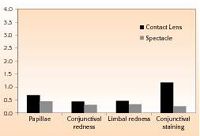Study documents comfort, safety of silicone hydrogel daily disposable compared with spectacle wear
Results from a study seem to dispel the myth that comfort and physiology may affect patients who are initiating contact lens wear.
San Francisco-Results from a prospective, randomized study seem to dispel the myth that comfort and physiology may affect patients who are initiating contact lens (CL) wear, said Jeffrey J. Walline, OD, PhD, here at the American Academy of Optometry's annual meeting.

Early findings
After 1 week of CL wear, results showed that spectacles were slightly more comfortable late in the day. However, after 1 month of wear, comfort was comparable between the two groups, which suggests that there may be a slight adaptation when adjusting to CL wear, said Dr. Walline, assistant professor, Ohio State University College of Optometry, Columbus.
Analysis of the collected physiology data noted statistical equivalence at a 99% confidence level for corneal vascularization, conjunctival hyperemia, limbal hyperemia and corneal staining at the 6-month visit. Conjunctival staining and papillary conjunctivitis were greater in the CL wearers at the 6-month interval.

"Most studies investigating new CLs will include patients wearing another CL as the comparator group. Our study design using spectacle wearers as the control is unique and allows us to address the assumptions that CLs are not as comfortable as spectacle wear and may compromise the ocular surface," said Dr. Walline.
"The findings from our study show that even in patients with no history of [CL] wear, this new [SiH DD CL], which combines oxygen transmissibility with the convenience of single use, is associated with similar comfort and ocular physiology compared with spectacle wear."
Dr. Walline noted that while the results of this study cannot be directly generalized to other CL products, the performance of other SiH DD CLs may be similar.
"Such studies have yet to be conducted," he said.
Newsletter
Want more insights like this? Subscribe to Optometry Times and get clinical pearls and practice tips delivered straight to your inbox.